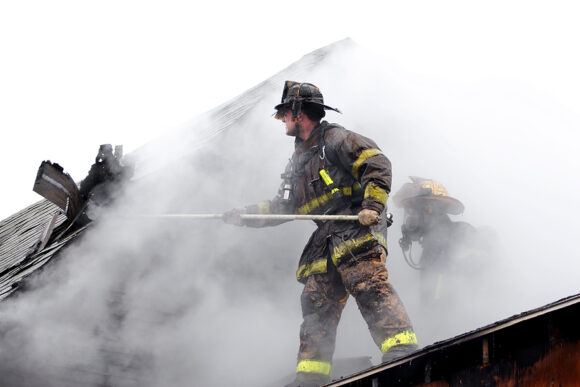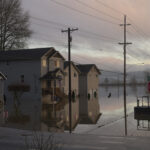Huntertown Fire Chief Mike Feely puts a sign outside the firehouse: accepting applications. No one stops.
Right after the 9/11 attacks, 15 to 20 people wanted to help. That interest lasted about four months. All the new people quit when faced with stringent guidelines, Feely said. He’s been lucky to get two recruits a year.
Then the Indiana station got creative. Bylaws were changed to allow non-Huntertown residents to volunteer. There were jaunts into a couple of high schools to tap interested students.
Today Feely has 11 new volunteers. Still, he can be forgiven if he’s a bit apprehensive.
“Keeping them is another story,” he told The Journal Gazette.
Indeed, with a nationwide shortage of volunteer firefighters, Huntertown can feel lucky.
The shortage is such that one Noble County volunteer firefighter is seeking a legislative remedy.
The New Haven mayor even included a plea for volunteers during his state of the city address last week.
“Volunteers are so important and play a vital role in the smooth operation of the fire department,” Mayor Terry McDonald said. “For anyone who has ever dreamed of being a firefighter, you can fulfill that dream in New Haven by becoming a volunteer firefighter.”
Little has changed since The Journal Gazette reported in 2006 that Indiana volunteer fire departments were struggling to maintain people. With volunteers spread out and fewer of them, volunteer departments have some of the slowest emergency response times in the state, the newspaper found. Some of the worst were in Brown County. At the time, one Brown County fire department had an average response time of 13 minutes.
Large city departments with full-time paid staffs, such as Fort Wayne’s, generally met a national 6-minute response standard.
Volunteers make up 69 percent of the nation’s fire service, according to the National Volunteer Fire Council. About 80 percent of Indiana’s firefighters are volunteers, said John Erickson, Indiana Department of Homeland Security spokesman.
“Obviously, volunteer departments do a lot of the heavy lifting,” he said. “And that’s not anything against career departments. They cover a lot of population in the large cities especially.”
Nationwide, volunteer firefighters per 1,000 residents dropped from 8.05 in 1987 to 6.37 in 2011, according to the National Fire Protection Association.
The shortage reflects a changing culture. Businesses are more reluctant to allow employees to leave at a moment’s notice to respond to a fire, said Robert Brownell, an Albion firefighter and paramedic. And training requirements put off some people, he added.
Columbia City Fire Chief Thomas LaRue notes that for many, household income declined during the Great Recession. With people working more hours to make ends meet, there isn’t time for volunteering, he said. The department has eight full-time firefighters and about 32 volunteers.
“I would like to have a greater turnout of firefighters on scene than what we currently have,” he said. “We have a lack of volunteers who are able to respond during daytime hours. I really don’t know what the answers are going to be to solve the issue.”
Brownell said his department is lucky to get five or six guys during the day. Noble County fire chiefs have agreed to a dual response to increase staffing
Brownell said his Noble County department offers a $7,600 scholarship toward an associate degree in public safety for Central Noble High School students if they agree to four years of department service. He said the last time he checked there were no takers.
Brownell terms the situation critical and a threat to public safety.
“Luckily we haven’t lost anybody to date,” he said.
Brownell is suggesting a tax credit for volunteers who have a 30 percent attendance rate at emergencies or perhaps an additional tax to maintain fire departments.
Rep. David Ober, R-Albion, said he has talked to Brownell and plans to seek legislation next year that could include a tax credit or other initiative. He calls the volunteer shortage “a huge problem.”
“As we continually increase the hours that folks have to go through for the training that they receive and as it becomes more and more expensive to do that, I think we’re going to have to look at legislation,” Ober said. “It’s just getting harder and harder to find young people that want to go through the training to become volunteer firefighters and it’s becoming harder to find employers who will take these people on and let them answer calls in the middle of the day.”
To smooth those bumps, Feely said, Huntertown made changes to its recruiting efforts. The fire department was getting requests outside of the city from trained volunteers wanting to join, he said. Bylaws had to be changed to accommodate them.
In addition, four Carroll High School cadets were recruited to observe operations at the department for volunteer or career interests, and two Churubusco High School students were given internships, one as a firefighter trainee and the other as a medic trainee.
Recruiting at schools has become significant, Feely said, because it is hard to tap older people with families and jobs to volunteer. While last year was the first time for that, firefighters had already begun attending school fire drills to become more visible, he said.
Whether the volunteers and students stick with it is another issue.
“Retention becomes a difficulty when they see how much is involved, not only from a local perspective and learning the system but also from the state’s perspective on keeping up with the hours of training and continuing education and all that kind of stuff,” Feely said.
Was this article valuable?
Here are more articles you may enjoy.


 Florida And East Coast Will See Big Losses From More Cat 5 Storms, Researchers Say
Florida And East Coast Will See Big Losses From More Cat 5 Storms, Researchers Say  LA Fires Push Insurers’ 2025 Disaster Losses to $107 Billion
LA Fires Push Insurers’ 2025 Disaster Losses to $107 Billion  Pacific Northwest Braces for Even More Flooding Rain This Week
Pacific Northwest Braces for Even More Flooding Rain This Week  Hermès Heir Sues Arnault and LVMH in $16 Billion Suit Over Lost Shares
Hermès Heir Sues Arnault and LVMH in $16 Billion Suit Over Lost Shares 